Abstract
Local activation of T lymphocytes is regarded as an important immunological component of psoriatic skin lesions. Within psoriatic plaques (PP) there are large numbers of dermal dendritic cells (DDCs) immediately beneath the hyperplastic epidermis surrounded by T cells. In this study we investigated the ability of DDCs isolated from PP skin to support immune responses to resting peripheral blood T cells. For comparison, other dendritic cells were obtained from blood of the same psoriatic patients, as well as DDCs from skin of normal healthy individuals (designated NN skin). All dendritic cells studied had high surface expression of HLA-DR, B7, and lymphocyte function associated antigen-1 molecules. T cell proliferative responses and cytokine production profiles to these various dendritic cells were measured in the absence and presence of PHA or bacterial-derived superantigens. In the absence of exogenous mitogens, PP skin-derived DDCs were much more effective stimulators of spontaneous T cell proliferation compared with either psoriatic blood-derived or NN skin-derived dendritic cells. Antibody blocking studies revealed involvement of HLA-DR, B7, and lymphocyte function associated antigen-1 on PP skin-derived DDCs. Cytokine profiles revealed that in the absence of exogenous stimuli PP skin-derived DDCs mediated a T cell response with high levels of IL-2 and IFN-gamma, but not IL-4 or IL-10. NN skin-derived DDCs produced a similar qualitative response, but quantitative amounts of all cytokines measured were lower. Upon addition of PHA or superantigens, both PP skin-derived and NN skin-derived DDCs mediated high levels of IL-2 and IFN-gamma production, with induction of IL-4 particularly evident for PHA reactions. Addition of conditioned medium from psoriatic dermal fragments did not enhance the autostimulatory capacity of blood-derived dendritic cells. These findings highlight the potent autostimulatory potential of PP skin-derived DDCs and suggest an important immunological contribution for these previously overlooked cell types contained within lesional skin sites.
Full text
PDF
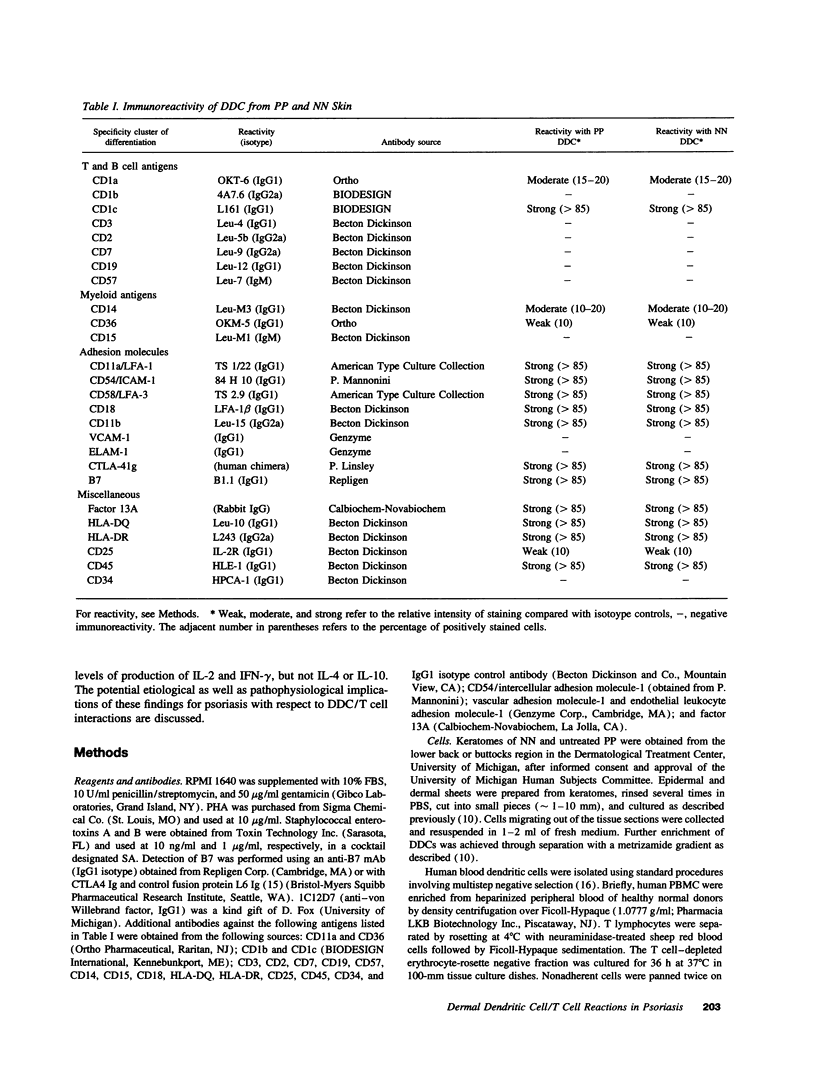
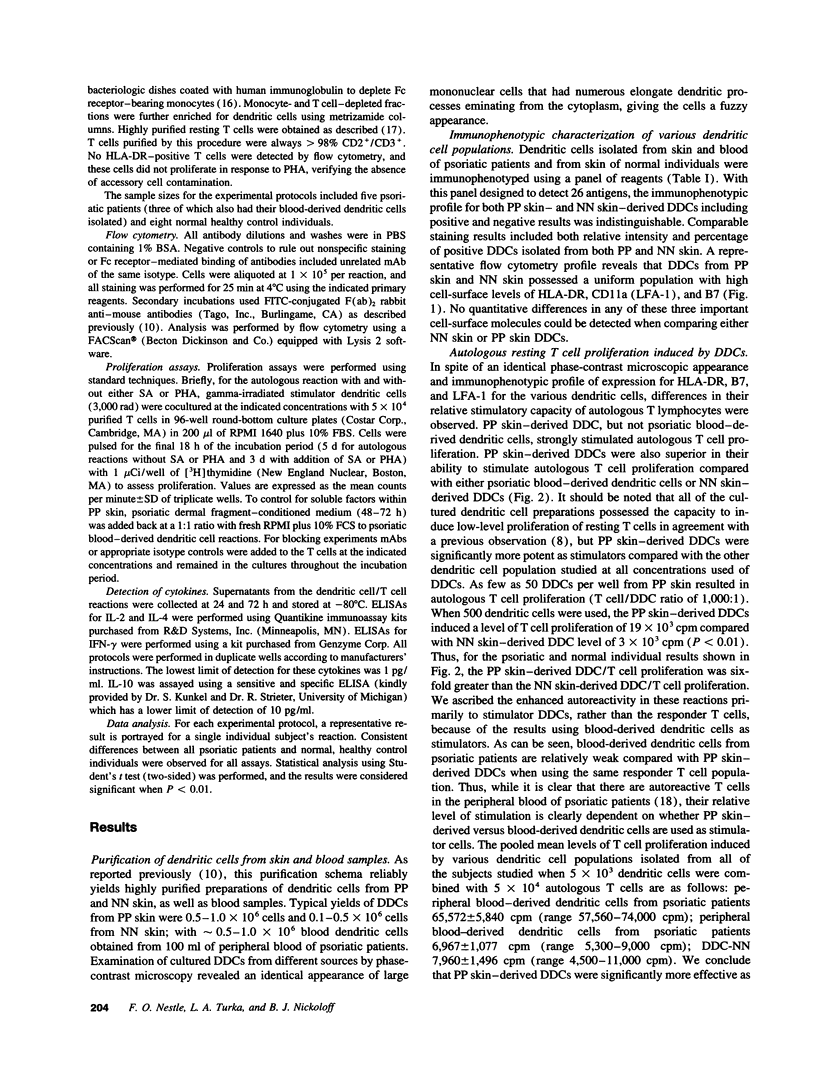
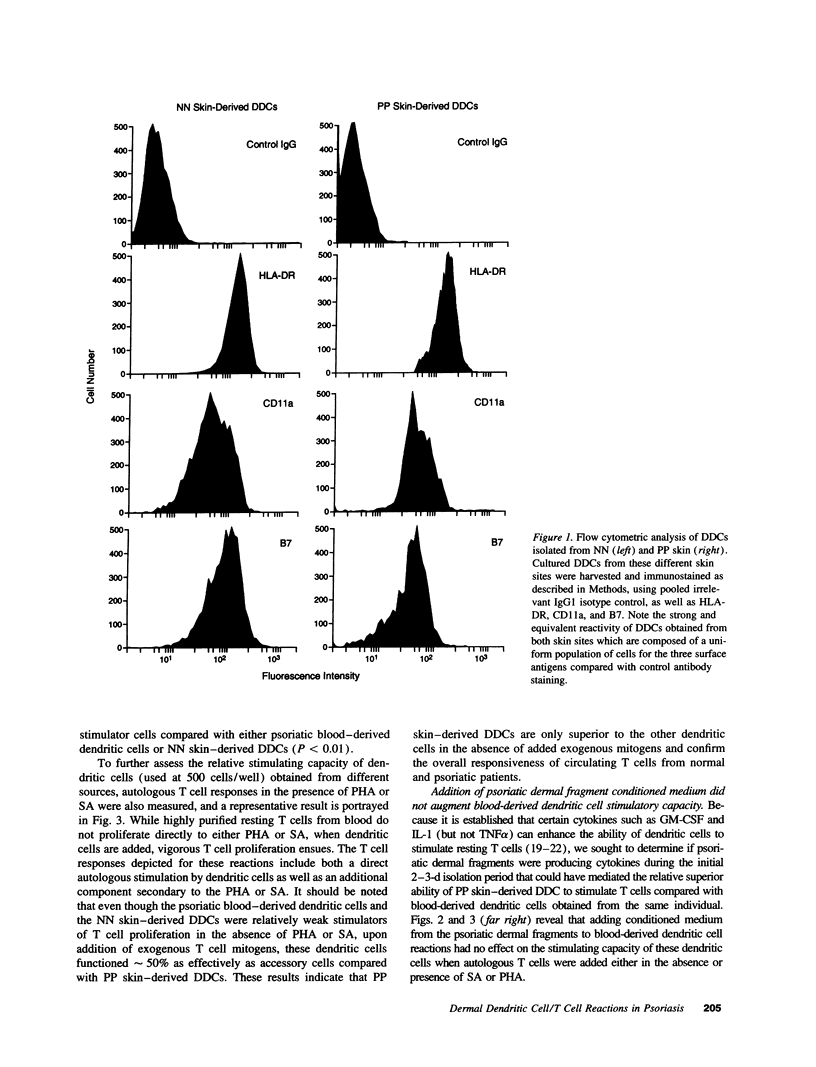
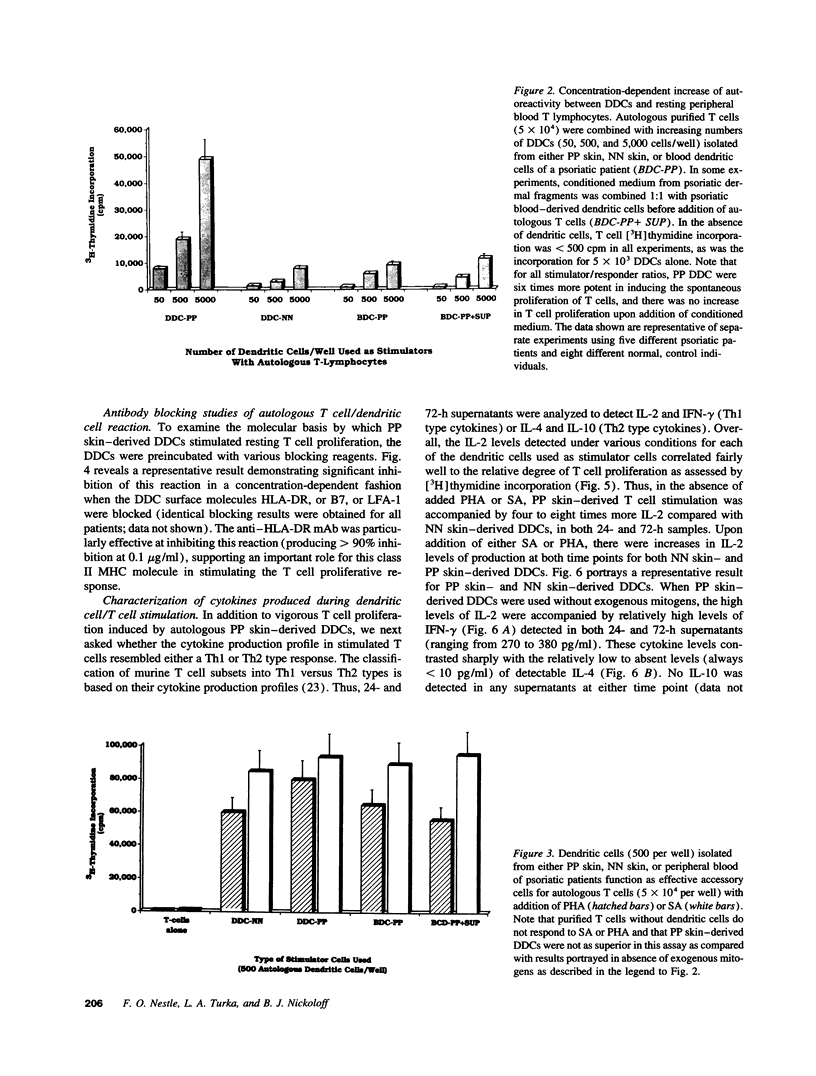
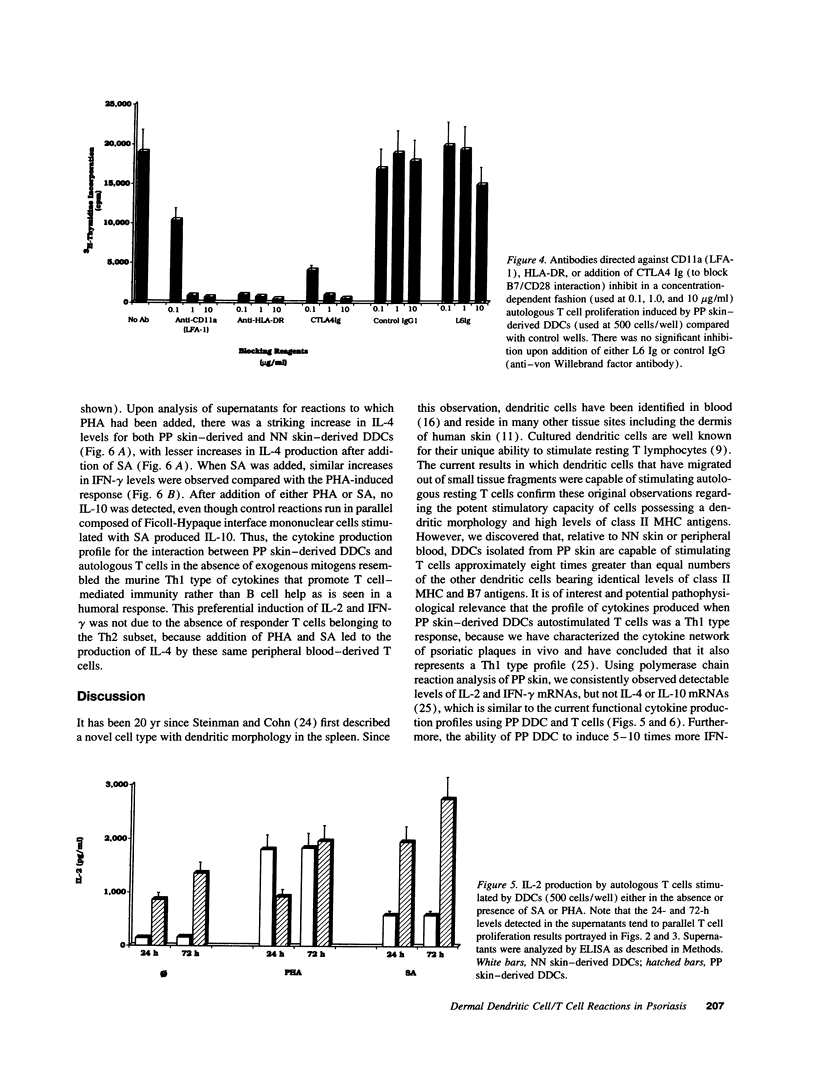
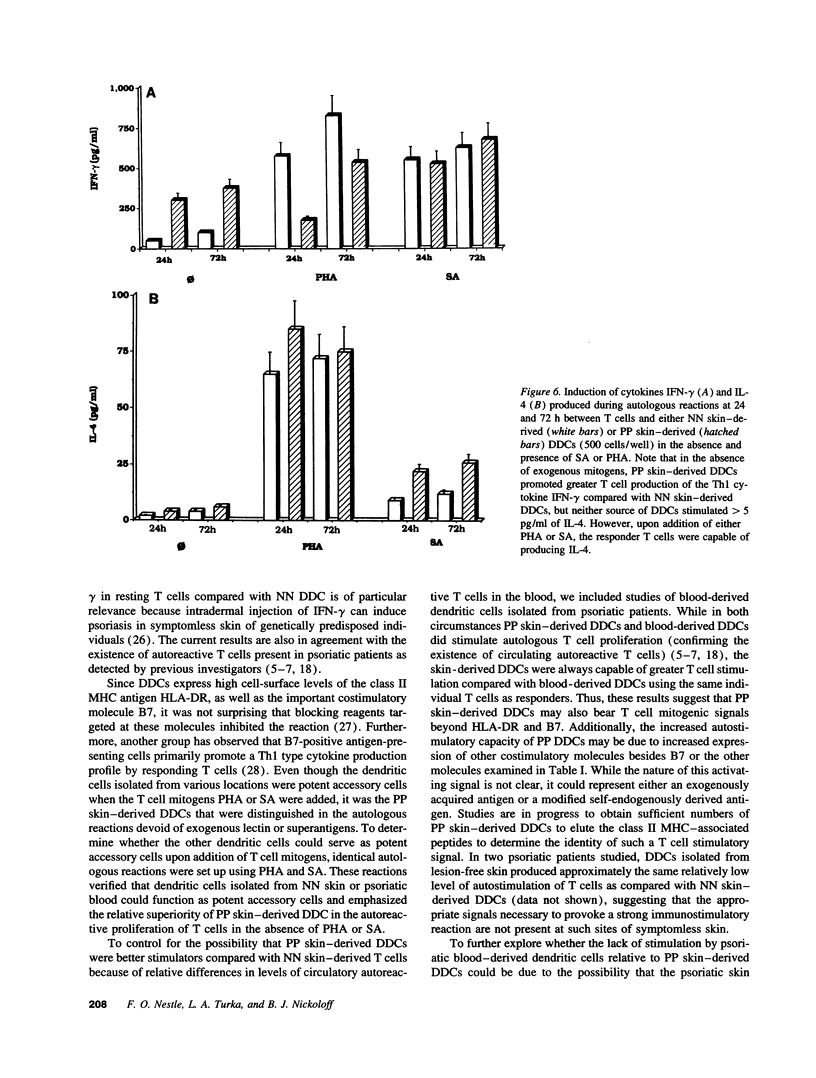
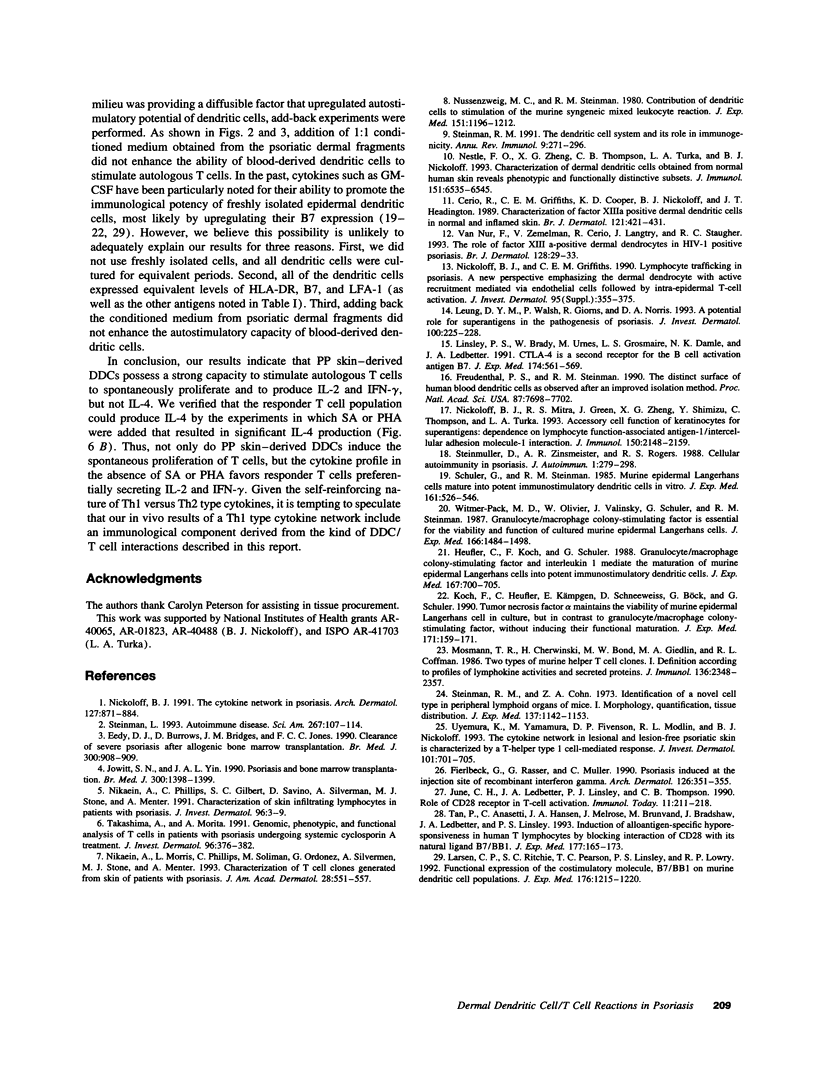
Images in this article
Selected References
These references are in PubMed. This may not be the complete list of references from this article.
- Cerio R., Griffiths C. E., Cooper K. D., Nickoloff B. J., Headington J. T. Characterization of factor XIIIa positive dermal dendritic cells in normal and inflamed skin. Br J Dermatol. 1989 Oct;121(4):421–431. doi: 10.1111/j.1365-2133.1989.tb15509.x. [DOI] [PubMed] [Google Scholar]
- Eedy D. J., Burrows D., Bridges J. M., Jones F. G. Clearance of severe psoriasis after allogenic bone marrow transplantation. BMJ. 1990 Apr 7;300(6729):908–908. doi: 10.1136/bmj.300.6729.908. [DOI] [PMC free article] [PubMed] [Google Scholar]
- Fierlbeck G., Rassner G., Müller C. Psoriasis induced at the injection site of recombinant interferon gamma. Results of immunohistologic investigations. Arch Dermatol. 1990 Mar;126(3):351–355. [PubMed] [Google Scholar]
- Freudenthal P. S., Steinman R. M. The distinct surface of human blood dendritic cells, as observed after an improved isolation method. Proc Natl Acad Sci U S A. 1990 Oct;87(19):7698–7702. doi: 10.1073/pnas.87.19.7698. [DOI] [PMC free article] [PubMed] [Google Scholar]
- Heufler C., Koch F., Schuler G. Granulocyte/macrophage colony-stimulating factor and interleukin 1 mediate the maturation of murine epidermal Langerhans cells into potent immunostimulatory dendritic cells. J Exp Med. 1988 Feb 1;167(2):700–705. doi: 10.1084/jem.167.2.700. [DOI] [PMC free article] [PubMed] [Google Scholar]
- Jowitt S. N., Yin J. A. Psoriasis and bone marrow transplantation. BMJ. 1990 May 26;300(6736):1398–1399. doi: 10.1136/bmj.300.6736.1398-c. [DOI] [PMC free article] [PubMed] [Google Scholar]
- June C. H., Ledbetter J. A., Linsley P. S., Thompson C. B. Role of the CD28 receptor in T-cell activation. Immunol Today. 1990 Jun;11(6):211–216. doi: 10.1016/0167-5699(90)90085-n. [DOI] [PubMed] [Google Scholar]
- Koch F., Heufler C., Kämpgen E., Schneeweiss D., Böck G., Schuler G. Tumor necrosis factor alpha maintains the viability of murine epidermal Langerhans cells in culture, but in contrast to granulocyte/macrophage colony-stimulating factor, without inducing their functional maturation. J Exp Med. 1990 Jan 1;171(1):159–171. doi: 10.1084/jem.171.1.159. [DOI] [PMC free article] [PubMed] [Google Scholar]
- Larsen C. P., Ritchie S. C., Pearson T. C., Linsley P. S., Lowry R. P. Functional expression of the costimulatory molecule, B7/BB1, on murine dendritic cell populations. J Exp Med. 1992 Oct 1;176(4):1215–1220. doi: 10.1084/jem.176.4.1215. [DOI] [PMC free article] [PubMed] [Google Scholar]
- Leung D. Y., Walsh P., Giorno R., Norris D. A. A potential role for superantigens in the pathogenesis of psoriasis. J Invest Dermatol. 1993 Mar;100(3):225–228. doi: 10.1111/1523-1747.ep12468941. [DOI] [PubMed] [Google Scholar]
- Linsley P. S., Brady W., Urnes M., Grosmaire L. S., Damle N. K., Ledbetter J. A. CTLA-4 is a second receptor for the B cell activation antigen B7. J Exp Med. 1991 Sep 1;174(3):561–569. doi: 10.1084/jem.174.3.561. [DOI] [PMC free article] [PubMed] [Google Scholar]
- Mosmann T. R., Cherwinski H., Bond M. W., Giedlin M. A., Coffman R. L. Two types of murine helper T cell clone. I. Definition according to profiles of lymphokine activities and secreted proteins. J Immunol. 1986 Apr 1;136(7):2348–2357. [PubMed] [Google Scholar]
- Nestle F. O., Zheng X. G., Thompson C. B., Turka L. A., Nickoloff B. J. Characterization of dermal dendritic cells obtained from normal human skin reveals phenotypic and functionally distinctive subsets. J Immunol. 1993 Dec 1;151(11):6535–6545. [PubMed] [Google Scholar]
- Nickoloff B. J., Mitra R. S., Green J., Zheng X. G., Shimizu Y., Thompson C., Turka L. A. Accessory cell function of keratinocytes for superantigens. Dependence on lymphocyte function-associated antigen-1/intercellular adhesion molecule-1 interaction. J Immunol. 1993 Mar 15;150(6):2148–2159. [PubMed] [Google Scholar]
- Nickoloff B. J. The cytokine network in psoriasis. Arch Dermatol. 1991 Jun;127(6):871–884. [PubMed] [Google Scholar]
- Nikaein A., Morris L., Phillips C., Soliman M., Ordonez G., Silverman A., Stone M. J., Menter A. Characterization of T-cell clones generated from skin of patients with psoriasis. J Am Acad Dermatol. 1993 Apr;28(4):551–557. doi: 10.1016/0190-9622(93)70073-3. [DOI] [PubMed] [Google Scholar]
- Nikaein A., Phillips C., Gilbert S. C., Savino D., Silverman A., Stone M. J., Menter A. Characterization of skin-infiltrating lymphocytes in patients with psoriasis. J Invest Dermatol. 1991 Jan;96(1):3–9. doi: 10.1111/1523-1747.ep12514646. [DOI] [PubMed] [Google Scholar]
- Nussenzweig M. C., Steinman R. M. Contribution of dendritic cells to stimulation of the murine syngeneic mixed leukocyte reaction. J Exp Med. 1980 May 1;151(5):1196–1212. doi: 10.1084/jem.151.5.1196. [DOI] [PMC free article] [PubMed] [Google Scholar]
- Schuler G., Steinman R. M. Murine epidermal Langerhans cells mature into potent immunostimulatory dendritic cells in vitro. J Exp Med. 1985 Mar 1;161(3):526–546. doi: 10.1084/jem.161.3.526. [DOI] [PMC free article] [PubMed] [Google Scholar]
- Steinman R. M., Cohn Z. A. Identification of a novel cell type in peripheral lymphoid organs of mice. I. Morphology, quantitation, tissue distribution. J Exp Med. 1973 May 1;137(5):1142–1162. doi: 10.1084/jem.137.5.1142. [DOI] [PMC free article] [PubMed] [Google Scholar]
- Steinman R. M. The dendritic cell system and its role in immunogenicity. Annu Rev Immunol. 1991;9:271–296. doi: 10.1146/annurev.iy.09.040191.001415. [DOI] [PubMed] [Google Scholar]
- Steinmuller D., Zinsmeister A. R., Rogers R. S., 3rd Cellular autoimmunity in psoriasis and lichen planus. J Autoimmun. 1988 Jun;1(3):279–298. doi: 10.1016/0896-8411(88)90033-9. [DOI] [PubMed] [Google Scholar]
- Takashima A., Morita A. Genomic, phenotypic, and functional analyses of T cells in patients with psoriasis undergoing systemic cyclosporin A treatment. J Invest Dermatol. 1991 Mar;96(3):376–382. doi: 10.1111/1523-1747.ep12466215. [DOI] [PubMed] [Google Scholar]
- Tan P., Anasetti C., Hansen J. A., Melrose J., Brunvand M., Bradshaw J., Ledbetter J. A., Linsley P. S. Induction of alloantigen-specific hyporesponsiveness in human T lymphocytes by blocking interaction of CD28 with its natural ligand B7/BB1. J Exp Med. 1993 Jan 1;177(1):165–173. doi: 10.1084/jem.177.1.165. [DOI] [PMC free article] [PubMed] [Google Scholar]
- Uyemura K., Yamamura M., Fivenson D. F., Modlin R. L., Nickoloff B. J. The cytokine network in lesional and lesion-free psoriatic skin is characterized by a T-helper type 1 cell-mediated response. J Invest Dermatol. 1993 Nov;101(5):701–705. doi: 10.1111/1523-1747.ep12371679. [DOI] [PubMed] [Google Scholar]
- Witmer-Pack M. D., Olivier W., Valinsky J., Schuler G., Steinman R. M. Granulocyte/macrophage colony-stimulating factor is essential for the viability and function of cultured murine epidermal Langerhans cells. J Exp Med. 1987 Nov 1;166(5):1484–1498. doi: 10.1084/jem.166.5.1484. [DOI] [PMC free article] [PubMed] [Google Scholar]
- van Neer F., Zemelman V., Cerio R., Langtry J., Staughton R. C. The role of factor XIIIa-positive dermal dendrocytes in HIV-1-positive psoriatics. Br J Dermatol. 1993 Jan;128(1):29–33. doi: 10.1111/j.1365-2133.1993.tb00142.x. [DOI] [PubMed] [Google Scholar]



